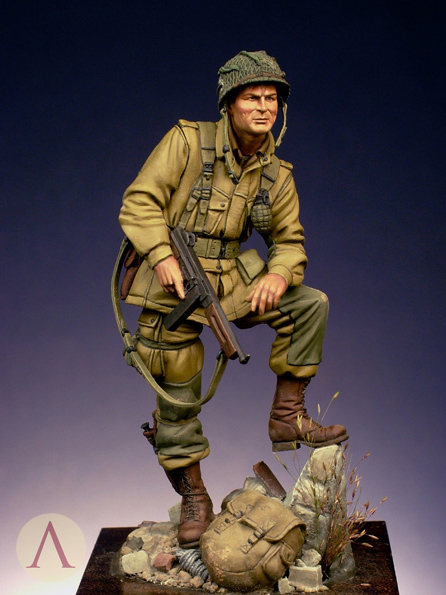 The 503d Parachute Regimental Combat Team , World War II began with the activation of the 503d Parachute Battalion in Fort Benning, Georgia on 21 August 1941. The Battalion was the third of four Parachute Battalions formed prior to the beginning of World War II. The others were 501, 502 and 504.
The 503d Parachute Regimental Combat Team , World War II began with the activation of the 503d Parachute Battalion in Fort Benning, Georgia on 21 August 1941. The Battalion was the third of four Parachute Battalions formed prior to the beginning of World War II. The others were 501, 502 and 504.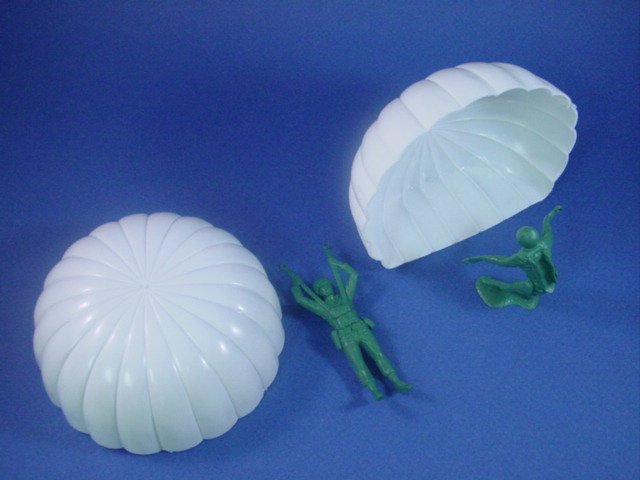
On 2 March 1942 the 503rd Parachute Battalion was the nucleus around which the 503d Parachute Infantry Regiment was formed. This was the first of a number of such regiments organized over the next few years. The Regiment was transferred to Fort Bragg, North Carolina in March 1942.
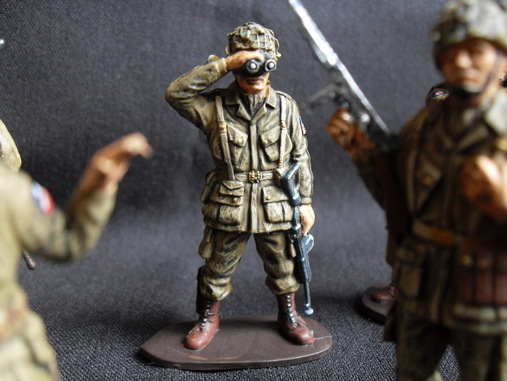
On 20 October 1942 the Regiment left the POE San Francisco on the MS Poelau Laut. The first stop was the Panama Canal Zone where the 501st Parachute Battalion was picked up. This battalion was redesignated as the Second Battalion of the 503d PIR, replacing the original 503d's Second Battalion which had been sent to England and, eventually, redesignated as the 509. The Regiment landed in Cairns, Australia on 2 December 1942 after a voyage of 43 days and 42 nights. Later the Regiment was expanded into a Combat Team with the assignment of the 462d Parachute Artillery Battalion on 29 March 1944 and the 161st Parachute Engineer Company on 13 September 1944.
During its more than three years service in the Southwest Pacific Theater, the 503d served in five major combat operations. A number of other missions were planned but called off by higher headquarters.
1. The Regiment jumped in the Markham Valley, New Guinea, on 5 September 1943, in the first successful Airborne Combat Jump. The Regiment forced the Japanese evacuation of a major base at Lae to take a route which proved to be disastrous for them. The third Battalion of the 503d had a major skirmish with the rear guard of this exodus. The successful employment of Parachute troops, in the Markham Valley, has been credited with saving the concept of vertical envelopment from being abandoned following several less than successful engagements in Europe.
2. Two rifle Battalions of the 503d Regiment jumped on the Island of Noemfoor off the coast of Dutch, New Guinea early in July 1944, followed by an amphibious landing by the other rifle Battalion a few days later. The Regiment was employed in the elimination of the Japanese garrison on that Island. Airfields constructed on Noemfoor after its capture played a significant role in supporting the advance of Allied troops from New Guinea to the Philippines. Sergeant Ray E. Eubanks was awarded the Congressional Medal of Honor, posthumously, for his actions on Noemfoor.
3. Following a non-combat landing on the Island of Leyte, in the Philippines, the 503d Parachute Regimental Combat Team made a major amphibious landing on the Island of Mindoro, in the central Philippines on 15 December 1944. Originally, it was intended for the 503rd to jump on Mindoro but due to inadequate airstrip facilities on Leyte an airborne landing was not possible. The purpose of this landing was to secure sites for air strips providing forward Air Corp bases to support later landings at Lingyen Gulf, Luzon. The Combat Team was subjected to intense air and naval actions during this operation, at one point being shelled for 25 minutes by a Japanese Naval task force.
One Company of the Combat Team engaged in a fierce battle against a Company-size enemy air raid warning station on the North end of Mindoro.
4. The Combat Team jumped on Fortress Corregidor on 16 February 1945 to liberate that Island from occupying Japanese forces. This was the most vicious combat action in which the Combat Team engaged during its existence. Corregidor was the bastion which withstood a fierce Japanese siege for nearly five months in 1941 and 1942, thereby interrupting the Japanese advance toward Australia. The 503rd was proud to have been allowed to have the honor of recapturing the Island. Japanese sources, within recent years have estimated there were 6550 Japanese on the Island when the 503rd landed. Of those, only 50 survived. The 503rd, however, lost 169 men killed and many wounded or injured. The 503rd was awarded the Presidential Unit Citation for its actions. Private Lloyd G. McCarter was awarded the Congressional Medal of Honor for bravery on Corregidor.
5. Almost immediately after returning to Mindoro from Corregidor, the Combat Team was called upon to bolster the 40th Division which was bogged down on the Island of Negros, in the Central Philippines. The Combat team was inserted into Negros by landing craft, although it had been alerted for another combat jump. The objectives of the proposed jump, a strategic bridge and a large lumber mill, were destroyed by Japanese forces, thereby eliminating the first objectives of the 503d. The 503rd engaged in fierce battles against frantic Japanese resistance in the mountainous areas of Negros for more than five months. The 40th US Division convinced higher headquarters there were only a few enemy troops remaining on the Island and were moved to Minanao, leaving the 503rd to battle the Japanese alone. At the end of the War with Japan in August 1945, about 7,500 of the surviving Japanese troops surrendered to the 503rd Parachute (below Clydecast)Regimental Combat Team.

Official U.S. War Department sources estimated the 503rd killed over 10,000 Japanese troops during its combat operations in the Southwest Pacific. Unfortunately, the 503rd lost a lot of good men in accomplishing its missions. The names of 392 of these men have been identified.
By early November 1945 the 503rd Parachute Regimental Combat Team ceased to be operational. All men with lengthy service in the Southwest Pacific had been rotated to the United States while those who had served the Combat Team for a shorter time had been reassigned to the 11th Airborne Division and sent as occupation troops to Japan. The Regiment was inactivated on 24 December 1945 at Camp Anza, California.
This brief history of 503rd PRCT was written by Don Abbot.
| A short primer on collecting a US Airborne army | ||
US Airborne are a good choise to get started with WW2 skirmish gaming. The US Para M1942 Uniform was issued to the troops early in the war and was officially in use until and including the D-Day landings. After the Normandy campaign the US introduced the olive green M1943 uniform but the old M1942 was still in use by some units until the end of the war.
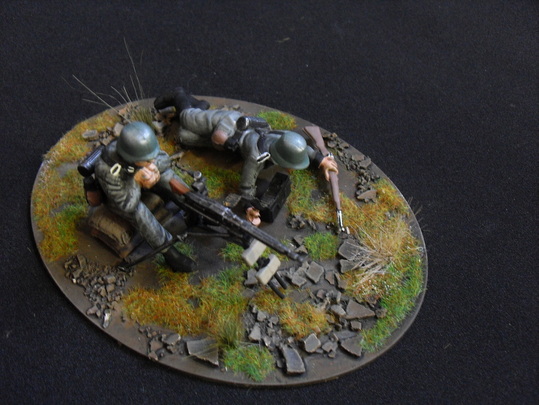
So an army of US Paras can be used in many theatres (North Africa, Sicily, Italy, France) throughout the war which makes them one the most versatile WW2 forces available.
I use 28mm miniatures from Artizandsigns for my games.
| ||
| The M1942 Uniform | ||
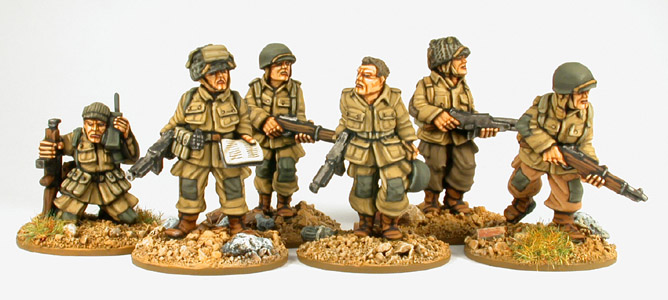 | ||
The M1942 was issued to Paratroopers only, Glidertroops used the standard US infantry uniform. The main difference (from the wargamers point of view) between these uniforms are the typical leg pockets on the Paratrooper's trousers so US Infantry can be converted into US Paratroopers without too much difficulties. See below for an Artizan radiomen with pockets on the blouse and trousers added, as well as a medipack and some camo on the helmet, painted as an US Para
| ||
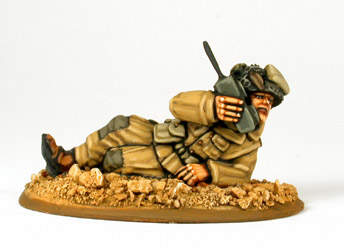 | ||
| US Para paintingguide | ||
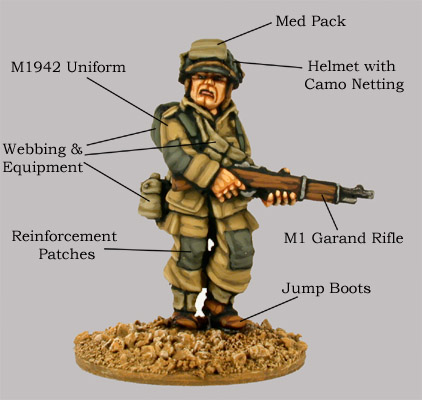 | ||
I'll make a list of the colours used for my models, unless otherwise noted I used balck or dark browns for shadows and white, light sand, ivory etc for the highlights. Mixtures can be varried which adds some flavour to the army and avoids a uniformed look. I paint on a black undercoat with the 3 Layer technique from dark to light. You might like to vary the mixtures to your tastes.
M1942: The colour of the M1942 is sand. It varries from tan sand to yellow sand and it is not greenish as some guides suggest. I have used Vallejo US Field Drap (873), Green Ocre (914) with white/sand for the highlight. The material used for the uniform was pretty weak and the men reeinforced it at ellbows and knees using material from the jump equipment. This should be dark green, brown or grey. Dark green is seen in most cases. Not everybody did this so you can vary this feature to add some colour to the army. To add some variety to my troops I have used different colours for some of the trousers, this can be any light brown you have available. Webbing and equipment: I've used Khaki or Khaki Grey for the webbing. It should be somewhat lighter than the uniform and the colours varied a lot. Light browns can also be used and I've seen this with drinking bottles especially. Bags and backpacks are often dark olive green, I've used Olive Green/Grey or US Dark Green in most cases. Helmet: The helmet is dark green or olive green. I've US Dark Green with some black in most cases. Use the same colours for the netting. Medpacks are khaki, chinstraps are leather. Rifle: Foundry Spearshaft with some black added for the wooden parts. Jump Boots: Jump boots are made of brown leather and I've used Foundry Tan. | ||
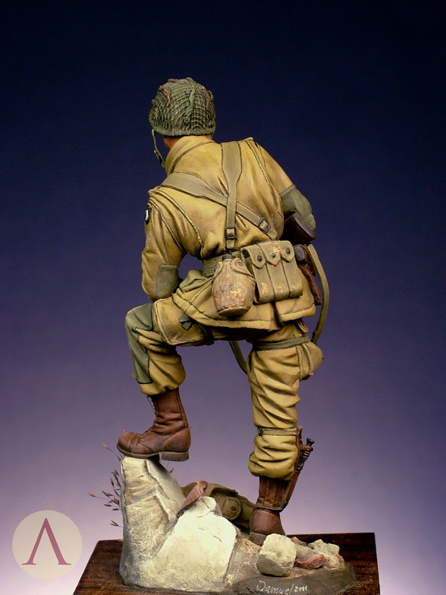
No comments:
Post a Comment